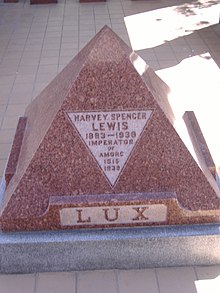Harvey Spencer Lewis
Harvey Spencer Lewis | |
|---|---|
 | |
| Born | November 25, 1883 Frenchtown, New Jersey, United States |
| Died | August 2, 1939 (aged 55) |
| Organization | AMORC |
| Title | Imperator of AMORC |
| Successor | Ralph Maxwell Lewis |
| Children | Ralph Maxwell Lewis |
Harvey Spencer Lewis (November 25, 1883 – August 2, 1939), a Rosicrucian author and mystic and the founder and first Imperator of AMORC, from 1915 until 1939.
Life and career
[edit]Lewis was born November 25 1883 in Frenchtown, New Jersey.[1] His parents were of Welsh and German ancestry,[1] to Aaron Rittenhouse Lewis and a German-born teacher, Katharina Hoffmann. He worked in advertising as an illustrator and he used that experience to promote AMORC, through print ads, booklets and magazine illustrations. Lewis first learned of the Rosicrucians through his interest in paranormal phenomena. His membership of a group investigating and exposing more than 50 fraudulent mediums[clarification needed] led to the formation of the New York Institute for Psychical Research, of which he was elected president at the age of 20.[2]
After he went with his father on a trip to France, he claimed that he had been given a mission to spread Rosicrucianism.[1]
Lewis engineered and supervised the creation of Rosicrucian Park, in San Jose, California, designing its unique buildings – the Egyptian-style temple, the fifth planetarium in the United States, a science laboratory, lecture auditorium, library, and administrative offices. Today his internationally recognised Rosicrucian Egyptian Museum on Naglee Avenue is a popular tourist attraction.
His second wife was Martha. They were married at least by 1917, according to his WW1 draft card, when they were living in Flushing, New York. In 1926, they sailed on the SS Majestic to Europe and made the first AMORC Grand Tour of Egypt.[3] reported en route in The Mystic Triangle of December 1926.
Under his nomen mysticum Sar Alden, Lewis was one of the three directors of FUDOSI (Federatio Universalis Dirigens Ordines Societatesque Initiationis) representing America, Europe and the Orient. That union of the world's authentic initiatic societies aimed to counter plagiarism of their ancient symbols and rituals by remnant groups and rivals.[4]
Works
[edit]In 1931, Lewis, under the pen name Wishar S[penle] Cerve,[5][6] wrote a book (published by the Rosicrucians) about the hidden Lemurians of Mount Shasta that a bibliographic note on Mount Shasta described as "responsible for the legend's widespread popularity."[7]
Lewis authored The Mystical Life of Jesus in 1929. The book is notable for defending a variant of the swoon hypothesis that Jesus survived his crucifixion.[8] Lewis plagiarized entire chapters from The Aquarian Gospel of Jesus the Christ by Levi H. Dowling.[9][10]
Death
[edit]
Lewis died in 1939. He was succeeded as leader of AMORC by his son, Ralph Maxwell Lewis. succeeded him in 1939 as the second Imperator of AMORC. One of Ralph Lewis's many books is the biography of his father, Cosmic Mission Fulfilled.
Bibliography
[edit]- Rosicrucian Principles for the Home and Business (1929)
- Explains portions of Rosicrucian teachings and philosophy as related to work and personal goals.
- Rosicrucian Questions and Answers with Complete History of the Order
- A two-part book: Part One gives the "traditional" history of the Rosicrucian Order, with names and works; Part Two answers common new member and prospective member questions.
- The Mystical Life of Jesus
- A retelling of the life story of Jesus; reportedly plagiarized Levi H. Dowling's Aquarian Gospel.
- The Secret Doctrines of Jesus
- An explanation of many symbols, standards, and interpretations of the work of Jesus and the Twelve Apostles.
- A Thousand Years of Yesterdays
- A fictional story, explaining reincarnation as a man re-experiences past selves.
- Self Mastery and Fate with the Cycles of Life
- Relates the Cycles of Life system, similar in nature to biorhythm.
- Rosicrucian Manual (1918, 1929 with reissues)
- Explains the structure of AMORC and includes everything a new Rosicrucian should know.
- Mansions of the Soul: The Cosmic Conception
- Essays about Life, Death, the Afterlife, and Rebirth.
- The Symbolic Prophecy of the Great Pyramid
- Presents an interpretation of Egyptian symbology, with old and new ideas discussed.
- Mental Poisoning
- An examination of curses, hexes, and psychic manipulation.
References
[edit]- ^ a b c Edighoffer 2005, p. 692.
- ^ Rebisse, Christian (2005). Rosicrucian History and Mysteries (1st ed.). AMORC, San Jose, Calif. pp. 153–159. ISBN 1-893971-05-8.
- ^ Rosicrucian Egyptian Museum & Planetarium Archived February 9, 2004, at the Wayback Machine at www.egyptianmuseum.org
- ^ Rebisse, Christian (2005). Rosicrucian History and Mysteries (1st ed.). AMORC, San Jose, Calif. pp. 191–193. ISBN 1-893971-05-8.
- ^ Cerve, Wishar S. (1931). Lemuria, The Lost Continent Of the Pacific (PDF). AMORC. title page.
- ^ Melton, J. Gordon (March 1999). Religious leaders of America: a biographical guide to founders and leaders of religious bodies, churches, and spiritual groups in North America (2nd ed.). Cengage Gale. p. 332. ISBN 978-0810388789.
- ^ Meisse, William C. (1993). Mount Shasta: an annotated bibliography. College of the Siskiyous. p. 146.
- ^ Kautz, William H. (2012). The Story of Jesus: An Intuitive Anthology. Trafford Publishing. p. 251. ISBN 978-1-4669-1808-5
- ^ Melton, J. Gordon. (1987). The Encyclopedia of American Religions, Volume 1. Gale Research Company. p. 593
- ^ Chryssides, George D. (2001). The A to Z of New Religious Movements. The Scarecrow Press. pp. 37-38. ISBN 978-0-8108-5588-5
- Sources
- Edighoffer, Roland (2005). "Lewis, Harvey Spencer". In Hanegraaff, Wouter J.; Faivre, Antoine; Broek, R. van den; Brach, Jean-Pierre (eds.). Dictionary of Gnosis & Western Esotericism. Leiden ; Boston, Mass: BRILL. ISBN 978-90-04-14371-5.
